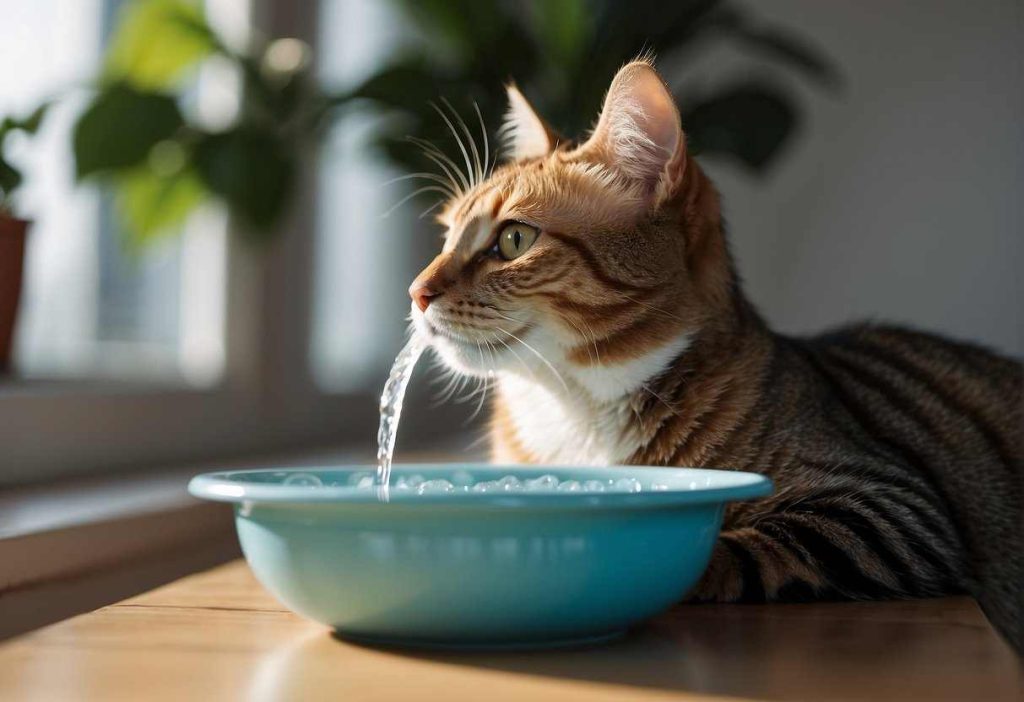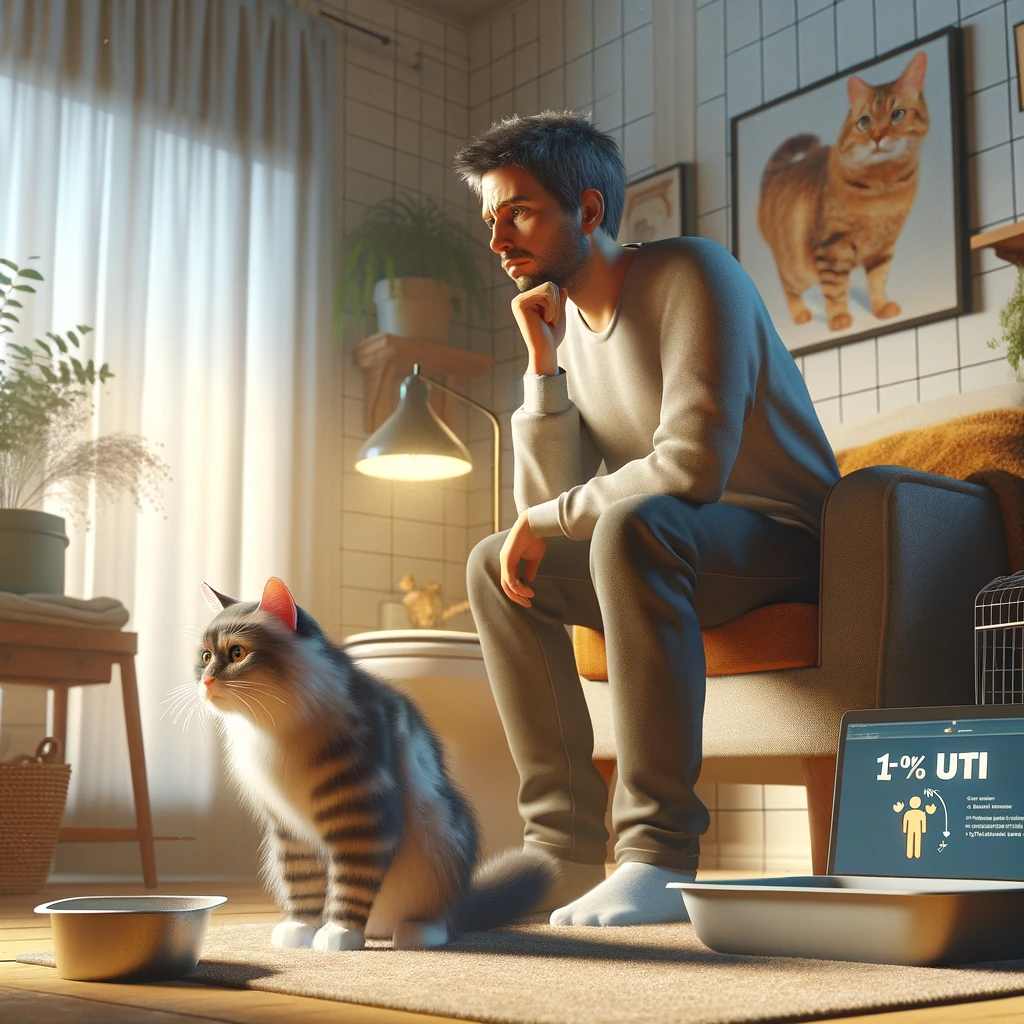Does your cat seem to be spending more time than usual in the litter box? Perhaps they appear to be in pain during urination, or you’ve noticed a change in the frequency or appearance of their urine.
These could be telltale signs of UTI in cats.
Urinary tract infections (UTIs) in cats are more than just uncomfortable – they can lead to serious health issues if unrecognized and untreated. (1)
These issues are common in cats and can lead to kidney failure if left untreated.
These infections of the bladder and urethra can affect cats of any age and breed but are more common in older cats (ages 6 and up). (2)
As a responsible cat owner, understanding the whisper signs of a UTI is crucial for your furry friend’s health and well-being.
Spotting a UTI early on can be the difference between a simple course of antibiotics and more severe urinary tract issues, especially in cats who may also suffer from endocrine diseases such as hyperthyroidism and diabetes mellitus. (3)
The urinary system is a vital part of a cat’s overall health, and recognizing signs of a UTI in cats older than 10 years of age is important for maintaining their well-being.

If your cat is showing any symptoms of urinary tract infection or other urinary problems, you should schedule an appointment with your veterinarian for immediate care.
Immediate attention is essential when you notice any unusual behaviors linked to their bathroom habits, sudden changes in their everyday routine, or if your cat (especially a male cat) has stopped urinating altogether (which may be due to being blocked).
Key Takeaways
- UTIs can cause significant health issues for cats, highlighting the need for early detection and understanding of symptoms.
- Changes in litter box behavior and visible discomfort during urination are common signs of UTIs in cats.
- Seeking veterinary care promptly when symptoms arise is essential for a proper diagnosis and effective treatment of UTIs in cats.
Recognizing the Signs of UTI in Cat
Common Symptoms of UTI in Felines:
- Frequent Urination: Does your cat seem to be in and out of the litter box more often than a kid on a candy high? (4)
- Pee-pee Problems: Ouch! That yowl might mean it’s more than just a quick pit stop.
- Seeing Red: Finding blood in their urine? That’s a signal bell you can’t ignore.
Behavioral Changes Indicating UTI:
- Litter Box Snubbing: If your cat’s giving the litter box the cold shoulder, it might be more than just a protest over brand preference.
- Grooming Overload: Is your kitty obsessing over cleaning their nether regions? UTIs can really tickle their tummy in the wrong way.
- Thirsty Much?: An uptick in water consumption could be telling you something’s up.
Keeping it short and sweet, these signs are your cue to get your furry buddy some help.
And remember, prompt veterinary attention is the key to a quick recovery, especially for male cats, who can have serious complications.
So, if your gut’s saying something’s off, trust that instinct. Your cat will thank you with more head-boops and purrs than you’ll know what to do with! Now, give that litter box a detective-worthy inspection.
When to Seek Veterinary Care

Have you noticed your furry friend making more frequent trips to the litter box? Or maybe they seem uncomfortable and even let out a little cry when they do their business?
If you’re nodding along, it might be time to talk about urinary tract infections (UTIs) in cats and when it’s critical to pick up the phone and call your vet.
Emergency Symptoms:
- Sudden inability to urinate: This could indicate a blockage, a true emergency.
- Blood in the urine: This one is a tell-tale sign; don’t wait on it. (5)
- Excessive grooming of the genital area: If your cat is paying a lot of attention down there, it could be a red flag.
Why Immediate Action Matters:
UTIs can create a lot of discomfort for your kitty, and in some cases, can lead to more serious conditions, like bladder stones or even kidney damage. (6)
Cats with diabetes mellitus, also known as sugar diabetes, as well as older female cats, are most prone to developing UTIs. Additionally, cats who have bladder stones are prone to recurrent UTIs.
To restore bladder health, you must dissolve or remove the bladder stones. It’s not just about dodging discomfort—it’s about protecting their health and reducing the greater risk of infection.
Plus, the earlier you address the issue, the easier it typically is to treat.
What’s Causing the Trouble?
| Common Causes | Risk Factors |
| Bacterial Infections | Older age or certain genders (like neutered males) |
| Bladder Stones and Crystals | Pre-existing conditions such as diabetes |
| – | Dietary habits that may affect urinary health |
Remember, your cat’s diet plays a crucial role in urinary health. A bit of prevention can go a long way, like ensuring they have access to clean water and are on a balanced diet with enough physical activity.
But, if you do spot the warning signs, a vet visit is your best bet for getting your buddy back to feeling purr-fect. So keep an eye out, stay informed, and your feline friend will thank you with cuddles and content purrs.
Diagnosing UTI in Cats

A urinary tract infection (UTI) could be the culprit, and proper diagnosis is the first step in getting your feline friend the relief they need.
Veterinary Diagnostic Procedures: Diagnosing a UTI in cats typically involves a combination of a physical examination and a detailed look at your cat’s medical history. Your vet may ask you questions like:
- How often is your cat attempting to urinate?
- Have you noticed any blood in the urine?
These answers play a crucial role in guiding the vet towards a diagnosis. But it doesn’t stop there. Seeing is believing, and that’s where urinalysis and urine culture come into play. Here’s what’s involved:
- Urinalysis: This test checks your cat’s urine for indicators such as blood, crystals, and white blood cells.
- Urine Culture: It’s like a science experiment that identifies the specific bacteria causing trouble, if present.
Understanding Test Results: Interpreting urinalysis findings can seem like a puzzle, but your vet’s expertise can piece it together.
A high presence of white blood cells or red blood cells might suggest infection, which can be confirmed by conducting a urinalysis on a fresh urine sample.
However, the urine culture is a critical follow-up—it reveals the bacteria strains and guides your vet to the ideal antimicrobial treatment.
Overcoming Information Shortfalls: You might have noticed a lack of emphasis on diagnostic processes in some resources, but understanding these procedures is key to catching UTIs early.
Early consultations with your vet are essential.
Remember, internet advice is helpful, but it’s no substitute for the knowledge and expertise of a certified vet who can run the proper tests and ensure your cat gets the best care possible.
Let’s get to the bottom of those symptoms and help your furry companion feel better soon!
Treatment Options for UTI in Cats

When your furry friend starts showing signs of a urinary tract infection (UTI), you’re probably wondering, “What can I do to help my cat feel better?”
Don’t fret; let’s talk about some effective treatments to get your cat back on track!
Medical Treatments:
- Antibiotics: If your vet confirms a bacterial UTI, they’ll likely prescribe antibiotics. Your cat must complete the entire course, even if they seem better before it’s finished.
- Pain Management: UTIs can be painful. Your vet may provide pain relievers and anti-inflammatory medications to ease your cat’s discomfort.
- Supportive Care: Sometimes, vets recommend hospitalization to manage severe cases, ensuring your cat receives fluids and close monitoring.
Dietary and Lifestyle Changes:
- Stay Hydrated: Encouraging your cat to drink more water is key. More fluid means more urine to flush out those pesky bacteria.
- Food for Thought: Special prescription diets can help manage UTI symptoms and prevent recurrence, focusing on modifying urine acidity and mineral content.
Here are a couple of steps to consider for initial care:
- Schedule a vet appointment at the first sign of discomfort.
- Provide fresh water daily and consider a cat water fountain to entice your pal to drink.
Remember, it’s better to be safe than sorry. If your cat is a male, any delay could be hazardous, so fast action is essential.
For non-emergency care, integrating canned foods and considering acidifiers like veterinarian-recommended supplements may assist in managing UTIs.
Keep an eye out for any changes in your cat’s behavior or bathroom habits. Taking these initial steps promptly can lead to a quicker recovery and less discomfort for your feline buddy.
And remember, you’re not alone; your vet is there to advise you on the best course of action for your cat’s unique needs.
Preventing UTI in Cats

Long-Term Health Management
Regular veterinary check-ups ensure any urinary issues are spotted early. Just like you, your cat can hide discomfort well, so those vet visits are crucial.
At home, become a detective of your cat’s litter habits—monitoring urinary health could be as simple as keeping an eye out for changes in the frequency and appearance of urine.
It is also important to schedule a complete physical exam for your cat to help assess their overall health and catch any potential issues early on.
This may include a urinalysis and other diagnostic tests such as ultrasound, radiographs, blood work, and a urine culture to diagnose and treat any underlying cause of your cat’s urinary symptoms. (7)
Long-term management of your cat’s urinary health, with the guidance of medical advice from your veterinarian, is crucial for their well-being.
Incorporating regular veterinary check-ups and lifestyle modifications into your feline health management strategy is essential for preventing urinary tract infections and ensuring the long-term well-being of your cat
Lifestyle Modifications
Curious about diet changes? Here’s a quick tip—hydration is key! An easy first step is to provide clean, fresh water always. A wet food diet can also help increase water intake.
Managing stress is less talked about but equally important. Cats love routine, so maintaining a consistent environment can work wonders. Consider these for environmental enrichment:
- Extra cozy hiding spots
- Lots of playtime
- Scratching posts galore
These tweaks might seem small, but they can lead to a big sigh of relief for your furry friend.
Enhancing Preventive Information
What else can you do? Remember, knowledge is power. Fill those gaps in your preventive measures by staying informed on the latest advice about feline urinary health.
Whether it’s upping your litter box cleaning game or trying pheromone diffusers for stress reduction, every bit helps.
Consider this just the start of your prevention toolkit. With awareness and simple changes, you’re on the path to safeguarding your pal’s urinary well-being.
No fluff, just the good stuff—because your cat deserves nothing but the best!
Quick Recap

Let’s remember, that only 1-3% of cats with lower urinary tract symptoms have a UTI.
However, staying on top of this by recognizing the signs and treating them with methods like cranberries to lower the pH of your cat’s urine can save you and your kitty some trouble and ensure a full recovery.
But if the issue persists, additional testing may be necessary.
Here’s what to watch for:
- Frequent trips to the litter box? Yes, it might be more than just being picky about cleanliness.
- Witnessing pain during urination? Yowls or discomfort are telltale signs.
- Accidents outside the box? It’s not spite; it could be a cry for help.
And if your furball is middle-aged or a tad on the heavier side, be extra vigilant. Stress isn’t a helper either; it can be a trigger even for healthy cats.
So, what can you do? A vet visit is the best move for a precise diagnosis since other conditions might mimic UTI symptoms. Expect a urinalysis to set the record straight—it’s a quick test providing vast insights.
Remember, you’re not alone in this. Many cat parents face urinary troubles with their pets, so seeking help and sharing insights is beneficial.
Keep things light, maintain an eye on that litter box behavior, and empower your kitty’s urinary health proactively. Together, you can tackle those sneaky UTIs head-on.
Stay observant, stay informed, and most importantly, stay in tune with your cat’s health. Your whiskery companion depends on it!
Frequently Asked Questions

When your furry friend starts acting up, it’s natural for you to have questions. Let’s scratch that itch for knowledge about UTIs in cats with some direct answers.
What are the first signs of a UTI in cats?
If you notice your cat scurrying frequently to the litter box but only producing tiny dribbles, or crying out in pain during urination.
Take note: these are often the first red flags that point towards a UTI.
Can indoor cats get UTIs?
Your homebound companion isn’t immune to UTIs. Regardless of their living environment, cats can develop urinary infections.
Are certain cat breeds more prone to UTIs?
Indeed, some breeds have a higher predisposition for urinary issues, but UTIs can be democratic in their choice—no breed is fully spared.
How can I differentiate between UTI and other urinary issues in cats?
Always consult your vet, as they will run a urinalysis to distinguish between UTIs and other conditions like crystals or bladder stones that can mimic UTI symptoms.
What home remedies can I use for a cat with a UTI?
Hold your horses there! Home remedies aren’t a substitute for veterinary care.
However, offering your cat plenty of water and a clean litter box can support their recovery.
Can a UTI in a cat resolve on its own?
Wishful thinking won’t cure UTIs. Skipping the vet visit might lead to more severe complications. Always seek professional advice for your meowing mate’s maladies.
How long does a typical UTI last in cats with treatment?
With proper treatment, most cats wave goodbye to UTIs within a week or two. But follow your vet’s advice—it’s the secret sauce for a swift recovery!


